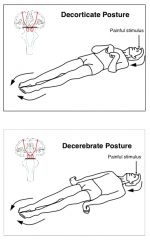![]()
![]()
![]()
Use LEFT and RIGHT arrow keys to navigate between flashcards;
Use UP and DOWN arrow keys to flip the card;
H to show hint;
A reads text to speech;
24 Cards in this Set
- Front
- Back
|
Five common features of movement disorders
|
• Impaired postural reflexes during movement or while stationary that would normally contribute to balance
• Hypokinesia or Hyperkinesia • Bradykinesia • Hyperkinesia • Ataxia |
|
|
Three types of tremors
|
• Physiological
• Resting • Intention.kinetic |
|
|
Def of Physiological tremor
|
A nonpathological tremor barely visible to the naked eye; it reflects low-amp cycle of flexion and extension of a region of the body
|
|
|
Resting Tremor
• is common in this disease • its appearance during voluntary movement • a secondary dysfxn of this tremor |
• common in Parkinson's disease
• the tremor wanes/gradually decreases in the body part of intended movement • Basal gangliar dysfxn is often 2ndary to it |
|
|
Intention/Kinetic tremor
• The period in a voluntary movement where the tremor normally appears • Often causes by lesions in this area |
• appear when the affected body part approaches a target
• Cerebellar lesions |
|
|
Chorea
• Often originates from this disease • Def |
• Often originates from basal gangliar disease
• brief, purposeless, irregular jerky movements of body parts |
|
|
Athletosis
• Often originates from this disease • Def |
• Often originates from basal gangliar disease
• Continuous slow writhing of body parts |
|
|
Ballismus
• Type of movements involved • Often involves lesions to this area |
• involuntary flinging movements of the arm and/or rotational movments of the leg
• Lesions to the subthalamic nucleus, a contributor to basal ganglia fxn |
|
|
Possible lesion sites for Hypokinetic d/os (3)
|
LMNs, the NMJ, Basal ganglia (or any dysfxn involving modulatory/regulatory circuits)
|
|
|
General differences between decorticate and decerebrate postures:
• red nucleus input • upper/lower limb positioning |

• Decorticate posturing has red nucleus input while decerebrate posturing has none
• Limb positioning - Decorticate: flexing of the upper limb, extension of lower limb - Decerebrate: extension of both upper & lower limbs |
|
|
Assessing Station
|
Ask patient to stand steadily w/ feet together and eyes closed. The visual system will be unable to compensate for other nervous deficits
|
|
|
Assessing Gait
|
Patient is asked to walk in a straight path w/ following visual cues and their ability to turn smoothly while reversing direction should also be observed.
|
|
|
List and Describe Six features of Parkinson's Disease
|
1) Facial masking - diminished facial expression
2) Muscle rigidity - expressed in various forms during a passive assessment passive movement - Cogwheel rigidity - Lead-pipe rigidity 3) Loss of Postural reflexes - failure to make adjustments in restoring equilibrium 4) Parkinsonian Gait - small shuffling steps with festination and difficulty turning 5) Loss of habituation to Glabellar Stimulations - tapping btwn the eyes to elicit lateral blinking 6) Speech - Quiet, hoarse and monotanous with festination |
|
|
Five stages of Parkinson's Disease
|
1. Unilateral
2. Bilateral but w/ preserved postural reflexes 3. Loss of postural reflexes 4. Severe disability but some movement 5. Akinesia |
|
|
Differential Diagnosis of Parkinson's Disease
• Which three tremors need to be discriminated? |
• Resting: + sign for Parkinson's
• Essential/Postural: only expressed when a particular posture is maintained • Intention: + for cerebellar disease |
|
|
Two diseases that feature choreoform movements and their etiology
|
Huntington's Disease: Autsomal dominant mutation
Sydenham disease: linked to rheumatic fever, has autoimmune characteristics |
|
|
Athetosis
• Def and disease it which it is linked • difficult to differentiate from these type of movements • often accompanies this condition |
• slow, continuous writhing movements linked to basal ganglia disease
• difficult to differentiate from choreoform movements • often accompanies hemiplagia with a hemiplegic gate |
|
|
Ballismus
• How hemiballismus is expressed in relation to the lesion |
Is expressed cotralaterally to the lesion
|
|
|
Dystonia
• Def • a specific type involving the neck |
• Involves muscle spasms or sustained abnormal postures involving the trunk and limbs
• Spasmodic torticollis |
|
|
Tourette's Syndrome
• Specific type of this d/o • The key to the diagnosis |
• a specific type of tic d/o
• The key dx is the vocal component which can involve barking or grunting |
|
|
Three types of drug-induced movement d/o
|
Tardive dyskiesia
Dopa-induced dyskinesis Drug-induced parkinsonism |
|
|
Tardive Dyskinesia
• may manifest with these type of drugs • common feature • affect upon drug withdrawal |
• antipsychotic/dopamine receptor antagonists
• oral movements • d/o does not necessarily abate |
|
|
Dopa-induced dyskinesia
• often arises during tx for this disease and w/ this drug • two manifestations |
• Often arises during tx w/ Parkinson's, L-dopa
• Choreoform movements, facial dystonia |
|
|
Drug-induced Parkinsonism
• can arise with agents/drugs performing these actions • Effect on agent/drug withdrawal |
• Block dopamine receptors or deplete stores of dopamine
• Sx dissipate within weeks |

